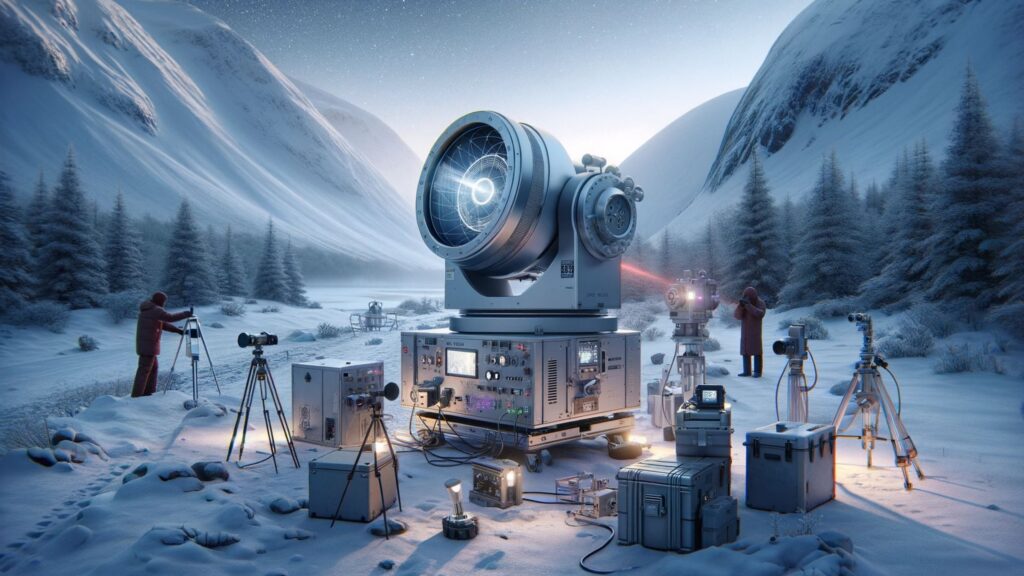Introduction to Project Hessdalen: Unraveling the Mysteries of the Sky
Project Hessdalen, nestled in the remote valley of Norway, has emerged as a focal point in the scientific study of unexplained aerial phenomena. For decades, this seemingly tranquil location has been host to a series of mystifying occurrences known as the Hessdalen lights. These lights, characterized by their unpredictable appearances and varied colors, have sparked both awe and intrigue worldwide.
A Journey from Obscurity to Scientific Prominence
The genesis of Project Hessdalen can be traced back to the early 1980s when the frequency and intensity of these light sightings reached an unprecedented peak. Capturing the public’s imagination, these phenomena also piqued the interest of the scientific community, leading to the formal establishment of a research initiative dedicated to uncovering the truth behind these enigmatic lights.
Bridging the Gap Between the Known and the Unknown

A Unique Approach to Scientific Inquiry
Project Hessdalen stands out in the scientific landscape for its commitment to exploring a phenomenon that defies conventional understanding.
The diverse nature of the lights, displaying an array of behaviors from rapid movements to sudden appearances, offers a fertile ground for research.
This project seeks to explain not only these occurrences but also challenges and expands the boundaries of current scientific knowledge.
The Heart of Innovation: Project Hessdalen’s Methodology

Leveraging Advanced Technology in Pursuit of Discovery
At the heart of Project Hessdalen’s investigative approach is the integration of state-of-the-art technology.
The project employs a sophisticated arsenal of tools, including high-resolution optical cameras and sensitive electromagnetic sensors.
These instruments are key to dissecting the behaviors of Hessdalen lights and potentially uncovering their origins.
Cultivating a Global Scientific Community
Beyond its technological advancements, Project Hessdalen serves as a beacon for international scientific collaboration.
The project has successfully united a diverse group of experts from various disciplines, fostering a rich exchange of ideas and perspectives.
This collaborative spirit is not only instrumental in advancing the project but also exemplifies the power of collective scientific endeavor.
A Revitalized Interest: The New Chapter of Project Hessdalen

The Global Resurgence of Fascination with the Unexplained
In recent years, Project Hessdalen has witnessed a significant resurgence in global interest. This renewed focus is partly attributable to a growing fascination with unexplained aerial phenomena worldwide.
The increasing public and scientific curiosity has brought fresh attention and resources to the project, enabling further advancements in research.
Pioneering the Future of Unexplained Phenomena Research
The ongoing developments in Project Hessdalen represent more than just the pursuit of understanding a local mystery.
They symbolize a broader quest for knowledge, pushing the boundaries of what is known and exploring the depths of the unexplained.
Each new finding and piece of data gathered not only sheds light on the Hessdalen lights but also contributes to our broader understanding of the natural world.
Project Hessdalen’s story is one of curiosity, determination, and the relentless pursuit of understanding the unknown.
Its journey from a local curiosity to a globally recognized scientific project highlights the power of inquiry and collaboration in unraveling the mysteries of our universe.
As the project continues to evolve, it serves as an inspiring reminder of the endless possibilities awaiting discovery in our world.
The Enigma of Hessdalen Lights

The Mysterious Lights of Hessdalen: A Spectacle in the Skies
The Hessdalen lights present a captivating enigma in the field of unexplained phenomena. These lights, often described as bright, colorful, and rapidly moving, have been a source of fascination and mystery.
Eyewitness accounts describe them as varying in shape and size, ranging from mere flashes to large, illuminated forms that light up the valley.
Historical Context: The Timeline of the Phenomenon
The recorded history of these lights dates back to at least the early 20th century, but it was in the 1980s that they gained significant attention.
During this period, the frequency of sightings increased dramatically, with reports of 15-20 sightings per week at their peak.
This surge led to the formation of Project Hessdalen in 1983, a scientific initiative aimed at studying these phenomena in a structured manner.
Eyewitness Accounts: The Personal Encounters
Eyewitnesses have provided detailed accounts of their experiences with the Hessdalen lights. Some describe them as bright white or yellow lights that appear both in the day and night, while others recall them changing color, sometimes displaying red or blue hues.
The lights have been observed to move with incredible speed, hover in the air, or even exhibit intelligent maneuvering patterns, adding to the complexity of their nature.
The Unique Setting of Hessdalen

Geographic Features: A Valley of Mystery
Hessdalen, a small valley in the central part of Norway, offers a unique geographic and environmental setting that contributes to the intrigue surrounding these lights.
The valley stretches approximately 12 kilometers in length and is surrounded by mountains, creating an isolated and serene backdrop for these mysterious occurrences.
Environmental Factors: A Scientific Puzzle
The environmental conditions in Hessdalen also play a crucial role in the study of these lights. The area is known for its rich deposits of minerals, including zinc, iron, and copper, leading some researchers to hypothesize a possible link between these geological features and the lights.
The valley’s climate, characterized by cold, humid conditions, may also influence the appearance and behavior of the phenomena.
The Role of the Hessdalen Atmosphere
The atmospheric conditions in Hessdalen have been a subject of interest for scientists. Studies suggest that the unique atmospheric composition, including a high level of humidity and the presence of airborne dust particles, could be factors contributing to the formation or visibility of these lights.
However, the exact relationship between these environmental elements and the Hessdalen lights remains a topic of ongoing research and debate.
The Hessdalen lights, with their rich history and enigmatic nature, continue to be a subject of fascination and study.
The unique geographic and environmental setting of Hessdalen provides a one-of-a-kind natural laboratory for researchers to explore these unexplained phenomena, offering glimpses into a world that bridges the known and the unknown.
As investigations continue, the lights of Hessdalen stand as a symbol of the enduring human quest to understand the mysteries of our universe.
The Scientific Quest to Understand the Unexplained

Embarking on a Scientific Expedition: The Genesis of Project Hessdalen
The scientific journey to unravel the secrets of the Hessdalen lights began in earnest with the establishment of Project Hessdalen in 1983.
This initiative marked a significant shift from mere curiosity to a structured, scientific approach to studying the phenomenon.
Spearheaded by a group of dedicated researchers, including Dr. Erling Strand from Østfold University College, the project aimed to gather empirical data and conduct systematic observations of the lights.
Multidisciplinary Approach: Integrating Diverse Scientific Fields
Project Hessdalen’s methodology is rooted in a multidisciplinary approach, drawing expertise from various scientific domains.
Researchers from fields such as astrophysics, meteorology, physics, and atmospheric science have come together to form a comprehensive understanding of the phenomenon.
This collaborative effort has been crucial in piecing together the puzzle of the Hessdalen lights, allowing for diverse perspectives and techniques to be applied.
The Tools of Discovery: Advanced Technologies in Research
A key aspect of Project Hessdalen’s research methodology has been the deployment of advanced technological instruments. The project utilizes a range of equipment, including:
- Automated Measurement Stations: These stations are equipped with cameras, radar, and sensors to capture real-time data on the lights. They operate continuously, ensuring round-the-clock monitoring of the valley.
- Spectrographic Analysis: By analyzing the light spectrum of the phenomena, researchers can identify potential chemical compositions and physical properties.
- Electromagnetic Field Measurements: Specialized equipment is used to detect and measure any electromagnetic fields associated with the lights, exploring the possibility of a geophysical connection.
Unraveling the Data: From Observation to Analysis
The heart of Project Hessdalen’s scientific quest lies in the meticulous analysis of the data collected. The project employs sophisticated data processing techniques to sift through the extensive amount of information gathered by the measurement stations. This analysis helps in identifying patterns, behaviors, and potential causes of the lights, bringing the researchers closer to understanding their nature.
Challenges and Limitations: Navigating the Uncharted Territory
Despite the advanced technology and collaborative efforts, the quest to comprehend the Hessdalen lights is not without challenges.
The unpredictable nature of the phenomenon makes it difficult to observe and study consistently. Additionally, the remote location and harsh environmental conditions of Hessdalen pose logistical and technical challenges to continuous research.
Fostering Global Scientific Dialogue: Sharing Knowledge and Insights
Project Hessdalen has become a hub for international scientific dialogue and cooperation. The project’s findings and methodologies are shared through conferences, publications, and collaborations with other research institutions.
This open exchange of information has not only enriched the project but has also contributed to the broader scientific understanding of unexplained aerial phenomena.
The scientific journey of Project Hessdalen exemplifies the relentless pursuit of knowledge in the face of the unknown. By harnessing the power of technology, collaboration, and scientific rigor, researchers continue to make strides in demystifying the enigmatic lights of Hessdalen.
As the project progresses, it remains a beacon of inspiration, showcasing the importance of curiosity and perseverance in the quest to unravel the mysteries of our world.
Technological Innovations and Methodologies in Project Hessdalen

Harnessing Cutting-Edge Technology to Unveil the Unknown
At the core of Project Hessdalen’s scientific quest lies an array of advanced technological tools and methodologies. These innovations are pivotal in capturing and analyzing the data related to the mysterious Hessdalen lights, offering insights that were previously unattainable.
Optical Cameras: Capturing the Visual Essence
- High-Resolution Imaging: The project employs high-resolution cameras capable of capturing detailed images of the lights. These cameras are essential for documenting the visual characteristics, including shape, size, and color changes of the phenomena.
- Night Vision Capabilities: Given that many sightings occur at night, night vision cameras are utilized to detect and record the lights under low light conditions. This technology ensures that no event goes unnoticed, regardless of the time of day.
Electromagnetic Sensors: Probing Beyond the Visible
- Magnetic Field Detectors: Electromagnetic sensors play a crucial role in the project. These devices measure magnetic field variations in the environment, which could be associated with the appearance of the lights.
- Radio Frequency Monitors: To capture any potential radio frequency emissions related to the lights, the project utilizes sensitive radio frequency monitors. This helps in understanding if the lights have any electromagnetic communication or interaction aspects.
Spectrographs: Deciphering the Light’s Composition
- Spectral Analysis: Spectrographs are used to analyze the light spectrum emitted by the phenomena. This analysis can reveal crucial information about the possible chemical elements present and the physical conditions of the lights, such as temperature and density.
- Real-Time Data Collection: The deployment of spectrographs in real-time monitoring stations allows for the immediate capture and analysis of the light spectra as events occur. This timely data collection is crucial for understanding the transient nature of the lights.
Deployment Strategies: Maximizing Data Collection Efficiency
- Automated Monitoring Stations: Strategically placed around the valley, these stations are equipped with the above technologies, operating continuously to ensure constant surveillance of the area.
- Mobile Units for Field Research: In addition to fixed stations, the project utilizes mobile units equipped with similar technologies. These units allow researchers to move to quickly and study locations of recent sightings, maximizing the chances of capturing data from different points in the valley.
- Data Integration and Analysis: The data collected from these various technologies are integrated and analyzed comprehensively. This involves sophisticated software and algorithms designed to sift through vast amounts of data, identify patterns, and extract meaningful information.
Challenges in Technology Deployment
- Environmental Factors: The harsh and unpredictable weather in Hessdalen poses challenges to the continuous operation of equipment. Measures are taken to ensure that the technology can withstand these conditions and provide reliable data.
- Technical Maintenance: Regular maintenance and updates of the equipment are necessary to keep the technology functioning optimally, which can be challenging in such a remote location.
The technological methodologies employed in Project Hessdalen are integral to its success in studying the enigmatic lights.
Through the combination of high-resolution imaging, electromagnetic sensing, and spectrographic analysis, the project has established a robust framework for investigating and understanding this mysterious phenomenon.
As technology continues to evolve, so too will the capabilities of Project Hessdalen in uncovering the secrets of the lights that dance in the Norwegian sky.
Challenges and Breakthroughs in Project Hessdalen

Navigating the Hurdles: The Challenges of Project Hessdalen
The journey to unravel the mysteries of the Hessdalen lights is fraught with challenges, each presenting unique obstacles to the researchers dedicated to this cause.
- Harsh Environmental Conditions: Hessdalen’s remote location in central Norway is characterized by extreme weather conditions, including heavy snowfall, cold temperatures, and limited accessibility, especially during the winter months. This harsh environment poses significant challenges for both the researchers and the technological equipment used in the project.
- Technological Limitations: Despite the advancements in technology, the equipment used in Project Hessdalen sometimes faces limitations in terms of sensitivity, resolution, and durability. Ensuring continuous operation and accurate data collection in the face of these limitations requires ongoing innovation and adaptation.
- Predictability of the Phenomenon: The unpredictable nature of the Hessdalen lights adds another layer of complexity. The lights do not follow a predictable pattern, making it challenging to ensure that monitoring equipment is focused on the right place at the right time.
- Funding and Resource Constraints: Like many scientific endeavors, Project Hessdalen operates within the constraints of funding and resources. Securing ongoing financial support is essential to maintaining and upgrading equipment, funding research activities, and supporting the team working on the project.
Illuminating the Dark: Breakthroughs and Findings
Despite these challenges, Project Hessdalen has achieved several significant breakthroughs, shedding light on this enigmatic phenomenon.
- Empirical Data Collection: One of the major achievements of the project has been the successful collection of empirical data on the lights. This data has provided a factual basis for understanding the characteristics and behaviors of the phenomena.
- Identification of Light Characteristics: Through continuous monitoring, the project has been able to identify and document various characteristics of the lights, such as their colors, speeds, and trajectories. This information is crucial for formulating hypotheses about their nature and origin.
- Atmospheric and Geophysical Correlations: Researchers have explored possible correlations between the lights and atmospheric or geophysical conditions in Hessdalen. While a definitive connection has not yet been established, this line of inquiry has opened new possibilities for understanding the phenomenon.
- International Collaboration and Recognition: Project Hessdalen has gained international attention and collaboration, bringing together experts from around the world. This global network has been instrumental in advancing the research and sharing findings with the broader scientific community.
The Path Forward: Continuing the Quest
The challenges faced by Project Hessdalen are matched by the team’s determination and ingenuity. As the project continues, the team remains committed to overcoming these obstacles, driven by the pursuit of knowledge and the potential for groundbreaking discoveries.
The future of Project Hessdalen holds the promise of new insights and a deeper understanding of one of the world’s most intriguing unexplained phenomena.
In conclusion, Project Hessdalen’s journey through challenges and breakthroughs underscores the resilience and dedication of scientific inquiry.
As the project advances, each finding adds a piece to the puzzle, bringing us closer to understanding the mysterious lights of Hessdalen and, perhaps, the broader mysteries of our universe.
Broader Implications and Future Directions of Project Hessdalen

Extending Beyond Hessdalen: Implications for Understanding Unexplained Aerial Phenomena
Project Hessdalen’s findings have significant implications for the broader field of unexplained aerial phenomena (UAP). The data and insights gained from this project contribute to a growing body of knowledge that challenges our understanding of the natural world.
- Redefining Aerial Phenomena Research: The systematic and scientific approach adopted by Project Hessdalen sets a new standard for UAP research. It demonstrates that with rigorous methods and advanced technology, it is possible to study these phenomena in a credible and empirical manner.
- Contributions to Atmospheric Science: The project’s research has potential implications for atmospheric sciences. By studying the Hessdalen lights, scientists can gain insights into atmospheric physics, electromagnetic phenomena, and possibly even new forms of energy or plasma behavior.
- Global UAP Research Network: The project has helped foster a global network of researchers and scientists dedicated to the study of UAP. This collaborative environment encourages the sharing of data, methodologies, and theories, advancing the overall understanding of these phenomena.
Envisioning the Future: Project Hessdalen’s Next Steps
Looking forward, Project Hessdalen continues to evolve, with plans to expand its research scope and deepen its scientific inquiries.
- Technological Advancements: There is an ongoing effort to upgrade and enhance the technological capabilities of the project. This includes implementing more sophisticated sensors, improving data processing algorithms, and integrating artificial intelligence to analyze the vast amounts of data collected.
- Expansion of Research Focus: Future plans include broadening the research scope to study not only the optical aspects of the lights but also their potential interactions with the environment and any physiological effects on observers.
- International Collaborations and Partnerships: Project Hessdalen aims to strengthen its international collaborations, partnering with universities, research institutions, and scientific communities worldwide. These partnerships are vital for pooling resources, sharing knowledge, and conducting joint research initiatives.
- Public Engagement and Education: The project also sees the importance of engaging with the public and the scientific community. Plans include organizing conferences, workshops, and educational programs to disseminate findings and foster a wider understanding of UAP.
Contributing to a Greater Understanding
The future directions of Project Hessdalen represent not just a continuation of its existing work but an expansion into new territories of scientific inquiry.
The project stands at the forefront of research into unexplained aerial phenomena, poised to make significant contributions to our understanding of these mysterious occurrences.
As Project Hessdalen moves forward, its impact extends far beyond the confines of a Norwegian valley. It stands as a beacon of scientific curiosity and innovation, contributing to a deeper understanding of the unexplained and inspiring future explorations into the unknown realms of our world.
The Enduring Legacy of Project Hessdalen in Scientific Exploration

Project Hessdalen stands as a significant milestone in the realm of scientific exploration, transcending beyond the investigation of a local phenomenon to impact the broader understanding of unexplained aerial phenomena.
Its importance lies not only in the pursuit of unraveling the mysteries of the Hessdalen lights but also in its contribution to the scientific methodology applied to study such enigmatic occurrences.
A Beacon of Scientific Curiosity and Rigor
- Advancing Scientific Understanding: Project Hessdalen has pioneered a path in the systematic study of UAP, emphasizing the need for empirical data collection, interdisciplinary collaboration, and technological innovation. This approach has broadened our understanding of atmospheric and geophysical phenomena, offering insights that could have far-reaching implications in various scientific fields.
- Setting a Precedent for Future Research: The project’s methodology serves as a blueprint for future research into similar phenomena worldwide. It demonstrates the feasibility and importance of applying rigorous scientific standards to areas that were previously relegated to the fringes of mainstream science.
The Call for Continued Support and Engagement
- Sustained Interest and Funding: The ongoing success and development of Project Hessdalen rely heavily on continued support, both in terms of public interest and funding. Sustaining this project requires a collective effort from the scientific community, funding bodies, and the general public, recognizing the value of such research in expanding our knowledge.
- Global Collaboration and Participation: Encouraging global collaboration and participation is essential. By fostering a network of researchers and institutions worldwide, the project can leverage diverse expertise and resources, leading to more significant discoveries and advancements.
- Public Awareness and Education: Raising public awareness about the scientific importance of projects like Hessdalen is crucial. Educating the public about the project’s findings and methodologies can inspire future generations of scientists and enthusiasts to explore the unknown with curiosity and scientific rigor.
A Journey into the Unknown
As we look towards the future, Project Hessdalen stands as a testament to the relentless human quest for understanding the mysteries of our natural world. It embodies the spirit of exploration and discovery that drives scientific progress.
As the project continues to uncover new findings and delve deeper into the unknown, it remains a symbol of hope and inspiration, reminding us of the endless possibilities that await in the uncharted territories of science and exploration.
As Project Hessdalen continues to unravel the mysteries of unexplained aerial phenomena, it offers valuable insights into a broader spectrum of similar occurrences around the world.
For those interested in exploring other intriguing events in this realm, including historical UFO crash retrievals, a comprehensive article titled “Top 10 UFO Crash Retrievals” provides an in-depth look at some of the most compelling cases.
This article complements the scientific endeavors of Project Hessdalen by offering a broader perspective on unexplained aerial phenomena and their impact on both history and modern investigation.

